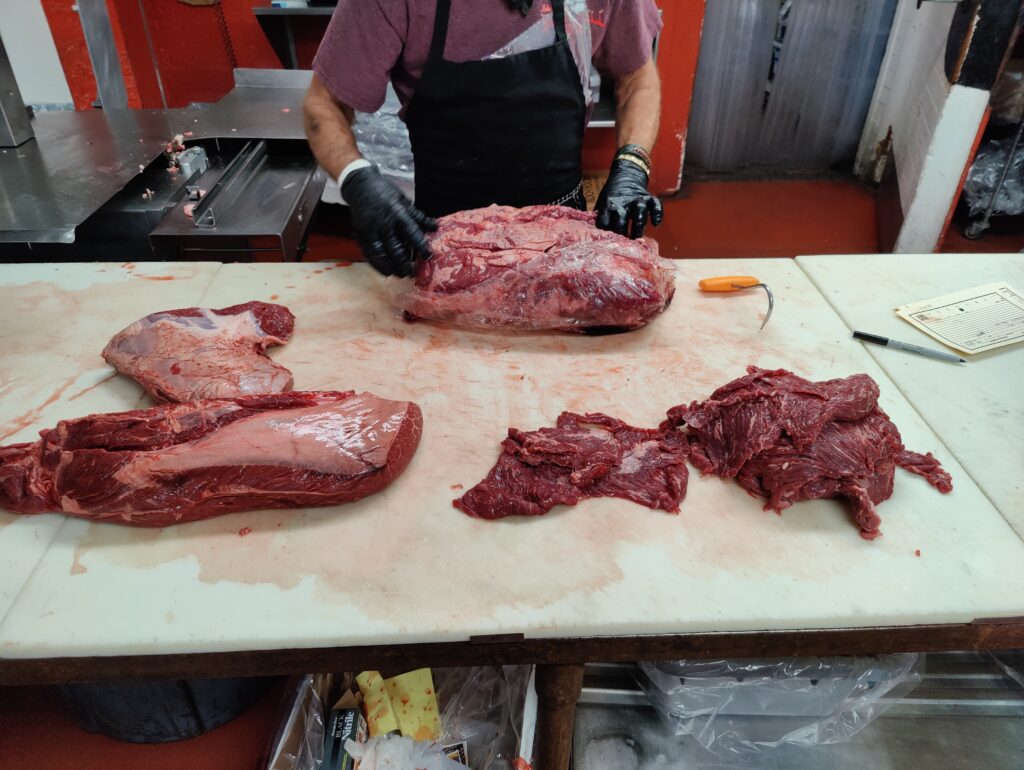Barbecue is more than just cooking; it’s a way to bring people together. Whether you’re new to grilling or a seasoned pro, picking the right cut of meat is key to making a great barbecue. In this guide, we’ll look at the best cuts of meat for BBQ, what makes each one special, and how to cook them just right.
Key Takeaways
- Choosing the right cut of meat is crucial for a great barbecue.
- Different meats like beef, pork, and chicken have unique cuts that are perfect for BBQ.
- Proper temperature control and patience are essential for cooking meat to perfection.
- Pairing your meat with the right type of wood can enhance its flavor.
- Experimenting with rubs and marinades can add unique flavors to your barbecue.
Understanding the Basics of Meat Cuts
Before diving into specific cuts, it’s important to understand the basics of meat cuts. Different parts of an animal offer different textures, flavors, and levels of tenderness. The primary animals used for BBQ are beef, pork, and chicken, each offering a variety of cuts that are ideal for different styles of barbecue.
Choosing the Right Cut for Your Barbecue
Factors to Consider
When selecting the perfect cut of meat for your barbecue, several factors come into play. Quality of meat is paramount; always opt for high-quality, fresh meat from a reputable source. The type of barbecue you’re planning, the cooking method, and personal preferences also matter. For instance, some cuts are better suited for slow cooking, while others are ideal for quick grilling.
Popular Beef Cuts for BBQ
Beef is a barbecue staple, known for its rich flavor. Here are some popular cuts:
- Brisket: This is the crown jewel of BBQ. It comes from the lower chest of the cow and is known for its tenderness and flavor when cooked low and slow.
- Ribs: Beef ribs are meaty and flavorful. There are two main types: back ribs and short ribs. Both are excellent for BBQ.
- Chuck: This cut comes from the shoulder and is often used for pulled beef or chopped BBQ beef due to its marbling and flavor.
Popular Pork Cuts for BBQ
Pork offers a variety of cuts perfect for smoking and grilling:
- Pork Shoulder (Boston Butt): Ideal for pulled pork, this cut comes from the upper part of the shoulder and is marbled with fat, making it perfect for slow cooking.
- Ribs: Pork ribs are a BBQ classic, with two main types: baby back ribs and spare ribs. Both are delicious but have different cooking requirements.
- Pork Belly: Known for its high fat content, pork belly can be smoked or grilled to create a crispy, flavorful BBQ dish.
Popular Chicken Cuts for BBQ
Chicken is versatile and can be prepared in numerous ways on the BBQ:
- Whole Chicken: Smoking or grilling a whole chicken is a great way to ensure juicy, flavorful meat.
- Chicken Thighs and Drumsticks: These cuts are more flavorful and juicy compared to chicken breasts, making them ideal for BBQ.
- Chicken Wings: Perfect for a quick BBQ snack, wings can be smoked, grilled, or fried.
Remember, the right cut of meat can make all the difference in your BBQ experience. Whether you’re a novice or a seasoned pitmaster, choosing the right cut is key to achieving that perfect, mouth-watering barbecue.
Tips for Perfect Barbecue
Importance of Meat Quality
Choosing high-quality meat is the first step to a great barbecue. Always buy from a reputable source to ensure freshness and flavor. Fresh meat will always give you the best results.
Temperature Control Techniques
Maintaining a consistent temperature is crucial. Use a good thermometer to keep track of the internal temperature of the meat. This helps in achieving the perfect doneness without overcooking.
Patience and Timing
Barbecue is a labor of love. Don’t rush the process. Cooking low and slow allows the flavors to develop and the meat to become tender. Remember, patience is key.
Resting the Meat
After cooking, let the meat rest. This step is crucial for retaining juices and enhancing flavor. Resting allows the juices to redistribute, making the meat more flavorful and juicy.
Pairing Meat with Wood for Smoking

The type of wood you use for smoking can greatly affect the flavor of your BBQ. Here are some popular wood choices and their best pairings:
Hickory and Its Uses
Hickory is known for its strong, smoky flavor, making it perfect for heavier meats like pork and beef, especially ribs. It’s a favorite among BBQ enthusiasts for its ability to impart a rich, hearty taste.
Mesquite: Bold and Earthy
Mesquite offers an intense, earthy flavor that pairs well with beef. However, it should be used sparingly due to its strong taste. It’s ideal for those who enjoy a bold, robust flavor in their BBQ.
Fruity Flavors of Apple and Cherry
Apple wood provides a mild, sweet flavor that is ideal for poultry and pork. Cherry wood, on the other hand, offers a sweet and fruity taste that pairs well with all meats, especially pork and chicken. These woods are great for adding a subtle sweetness to your BBQ.
Versatility of Oak
Oak is a versatile wood that provides a balanced, mild smoky flavor suitable for all meats. It’s a great choice if you’re looking for a wood that can be used for a variety of BBQ dishes.
When choosing wood for smoking, remember that hardwood is recommended for heavier meats like beef and pork, while lighter hardwoods are better for more delicate meats like chicken and fish.
Experimenting with Rubs and Marinades

Basic Rub Recipes
Creating a good rub is essential for adding flavor to your barbecue. A simple all-purpose rub can elevate your chicken and pork barbecue. Here’s a basic recipe to get you started:
- 1/4 cup brown sugar
- 1/4 cup paprika
- 2 tablespoons black pepper
- 2 tablespoons salt
- 1 tablespoon chili powder
- 1 tablespoon garlic powder
- 1 tablespoon onion powder
- 1 teaspoon cayenne pepper
Mix all the ingredients together and store in an airtight container. This rub works well on all types of meat.
Creating Your Own Marinades
Marinades are great for adding moisture and flavor to your meat. A basic marinade includes an acid (like vinegar or lemon juice), oil, and seasonings. Here’s a simple marinade recipe:
- 1/2 cup olive oil
- 1/4 cup soy sauce
- 1/4 cup lemon juice
- 1/4 cup Worcestershire sauce
- 2 tablespoons garlic, minced
- 2 tablespoons fresh herbs (like rosemary or thyme)
- 1 teaspoon black pepper
Combine all ingredients in a bowl and mix well. Place your meat in a resealable bag, pour the marinade over it, and refrigerate for at least 2 hours, preferably overnight.
Balancing Flavors
When creating your own rubs and marinades, it’s important to balance the flavors. Sweet, salty, spicy, and savory elements should complement each other. For example, if your rub is very sweet, balance it with a bit of salt and spice.
Marinating Times and Techniques
The length of time you marinate your meat can affect its flavor and texture. Here are some general guidelines:
- Chicken: 2-6 hours
- Beef: 4-24 hours
- Pork: 2-12 hours
- Fish: 30 minutes to 1 hour
Always marinate meat in the refrigerator to prevent bacterial growth. For best results, turn the meat occasionally to ensure even exposure to the marinade.
Experimenting with different rubs and marinades can take your barbecue to the next level. Don’t be afraid to try new combinations and find what works best for you.
Essential BBQ Tools and Equipment
Must-Have Grilling Tools
To get started with BBQ, you’ll need some essential tools. Quality tools can make a big difference in your grilling experience. Here are some must-haves:
- Tongs: A good pair of tongs is crucial for flipping and moving meat without piercing it.
- Spatula: Ideal for flipping burgers and other flat items.
- Basting Brush: Helps in applying sauces and marinades evenly.
- Grill Brush: Keeps your grill clean and free from residue.
- Meat Thermometer: Ensures your meat is cooked to the right temperature.
Choosing the Right Smoker
Selecting the right smoker can elevate your BBQ game. There are several types to consider:
| Type | Description |
|---|---|
| Charcoal | Offers a traditional smoky flavor. |
| Gas | Convenient and easy to control. |
| Electric | Simple to use, great for beginners. |
| Pellet | Combines the ease of electric with wood flavor. |
Thermometers and Temperature Probes
Maintaining the right temperature is key to perfect BBQ. Invest in a reliable thermometer and temperature probes to monitor both your grill and meat temperatures. This ensures your meat is cooked safely and to your desired doneness.
Maintenance and Care
Taking care of your BBQ tools and equipment will extend their life and keep them performing well. Here are some tips:
- Clean your grill after each use to prevent buildup.
- Store tools in a dry place to avoid rust.
- Regularly check and replace any worn-out parts.
Remember, the best grilling tools can make your BBQ experience smoother and more enjoyable. Happy grilling!
Conclusion
Barbecue is more than just cooking; it’s a way to bring people together and create lasting memories. By choosing the right cuts of meat, controlling the temperature, and being patient, you can make your BBQ truly special. Don’t forget to let the meat rest and experiment with different woods and flavors. Whether you’re a beginner or a seasoned pro, there’s always something new to learn and enjoy. So fire up the grill, gather your loved ones, and savor the delicious results of your hard work. Happy grilling!
Frequently Asked Questions
What are the best cuts of beef for barbecue?
Top cuts of beef for BBQ include brisket, ribs, and chuck. Brisket is great for slow cooking, ribs are flavorful, and chuck is perfect for pulled beef.
How do I choose the right cut of pork for my BBQ?
The best pork cuts for BBQ are pork shoulder, ribs, and pork belly. Pork shoulder is ideal for pulled pork, ribs are a classic choice, and pork belly offers rich flavor.
What chicken cuts work best for grilling?
Chicken thighs, drumsticks, and wings are excellent for grilling. They are juicy and flavorful, making them perfect for BBQ.
Why is resting meat important after cooking?
Resting meat allows the juices to redistribute, making the meat more tender and flavorful. It’s a key step for great BBQ.
What types of wood are best for smoking meat?
Different woods add unique flavors. Hickory is strong and smoky, mesquite is bold, apple and cherry are fruity, and oak is versatile.
How can I ensure my barbecue is cooked properly?
Use a good thermometer to check the internal temperature of the meat. Consistent temperature control and patience are also crucial for perfect BBQ.

